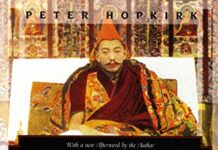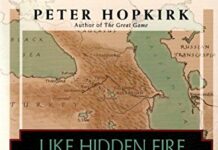
Ebook Info
- Published: 2006
- Number of pages: 272 pages
- Format: PDF
- File Size: 1.51 MB
- Authors: Peter Hopkirk
Description
The Silk Road, which linked imperial Rome and distant China, was once the greatest thoroughfare on earth. Along it travelled precious cargoes of silk, gold and ivory, as well as revolutionary new ideas. Its oasis towns blossomed into thriving centres of Buddhist art and learning. In time it began to decline. The traffic slowed, the merchants left and finally its towns vanished beneath the desert sands to be forgotten for a thousand years. But legends grew up of lost cities filled with treasures and guarded by demons. In the early years of the last century foreign explorers began to investigate these legends, and very soon an international race began for the art treasures of the Silk Road. Huge wall paintings, sculptures and priceless manuscripts were carried away, literally by the ton, and are today scattered through the museums of a dozen countries. Peter Hopkirk tells the story of the intrepid men who, at great personal risk, led these long-range archaeological raids, incurring the undying wrath of the Chinese.
User’s Reviews
Editorial Reviews: Review ‘Recounted with great skill . . . opens a window onto a fascinating world’―Financial Times’Highly readable and elegant’―Times Literary Supplement About the Author Peter Hopkirk travelled widely in the regions where his six books are set – Central Asia, the Caucasus, China, India and Pakistan, Iran, and Eastern Turkey. He worked as an ITN reporter, the New York correspondent of the old Daily Express, and – for twenty years – on The Times. No stranger to misadventure, he was twice held in secret police cells and was also hijacked by Arab terrorists. His works have been translated into fourteen languages.
Reviews from Amazon users which were colected at the time this book was published on the website:
⭐Peter Hopkirk’s books consistently succeed in highlighting fascinating episodes of 19th-20th century history in ways that are accurate, well written, and highly readable. Hopkirk’s books are also extremely relevant for our understanding of the modern world. One cannot really understand current events in Afghanistan, South Asia, and the newly emergent independent republics of Central Asia without knowing their deep cultural histories and the role of competition between European powers in shaping the boundaries, internal rivalries, and political structures of these countries. Hopkirk’s book “The Great Game” did a brilliant job of describing 19th Russian-British shadow struggle for control over India and its borderlands.In “Foreign Devils on the Silk Road”, Hopkirk explores a different, but equally fascinating rivalry – the competition among English, French, German, Japanese, and Scandanaian adventurer-scholars to explore the newly discovered early Buddhist civilizations that flourished in the desert oases of Xinjiang in westernmost China. These first millennium AD sites along the Silk Road trade route literally were the missing link connecting the civilizations of the Near East, South Asia, Central Asia, and China; and as such they had tremendous historical importance. As soon as European researchers learned of the remains of lost cities poking through the sands of the Taklamakan desert, archaeologists, philologists and art historians began a race to “acquire” the priceless artwork and manuscripts at these newly discovered sites. “Foreign Devils” describes the intrepid European (and even American) explorers who struggled through dangerous deserts and bandit-infested territories to reach these sites and explore their remains. Hopkirk focuses much of his account on the explorations of Sir Aurel Stein (no relation to this reviewer), and his acquisition for the British Museum of the priceless Buddhist manuscripts from the monastic caves of Dunhuang.But the story is much more than a tale of exploration. Hopkirk correctly and directly addresses the ethical questions involved in the removal by westerners of these irreplaceable items of cultural heritage – sometimes by purchase, sometimes through deception, and sometimes through outright looting and theft. From our modern standpoint, it is easy to say that the Europeans had no right to take these treasures of Buddhist civilization. And yet – Chinese scholars were slow to recognize the importance of the sites and monuments of the Taklamakan, and did not act to assert their right to protect them by excluding foreign explorers until the 1920’s. Had scholars such as Stein and Pelliot not removed them, most of these treasures would most likely have been destroyed, looted, or vandalized and otherwise lost forever. Ironically – some of the most important early Buddhist frescoes from western Xinjiang that were brought back to Germany ended up being destroyed in the Allied bombing of Berlin. Hopkirk reminds us that the loss of these treasures – especially the Dunhuang library – is still a source of deep anger to China. This raises the complex question of the rights of modern countries to demand the repatriation of cultural heritage that had been removed from the lands under their sovereignty – whether legally or illegally under the laws that were in force at the time of their removal.”Foreign Devils” is thus a fascinating piece of history that has very real and immediate implications for modern politics and international relations. This is a thought-provoking tale that should be pondered by all who wonder at the treasures on display in the great art museums of the world. I strongly recommend this book.
⭐After reading “The Great Game”, I have been on a Peter Hopkirk binge ever since. I was a little skeptical regarding “Foreign Devils”, I mean I have no artistic inclinations to speak of. So I was pleasantly surprised how much I enjoyed this book.Again the setting is in Central Asia, specifically the Taklamakan Desert. The time frame is also typical of the author: approximately 1895 to 1920s. Hopkirk gives a good, although not overly in-depth background of the old Silk Road routes that primarily skirted the edges of this vast waste. Most history readers will have a cursory grasp of the Silk Road and its historical significance. Suffice to say that many of the towns that existed along this route ebbed and flowed with climate and economic changes.The ‘hook’ that really grabbed me early in the story was about Hellenistic artistic influences combining with that of the more traditional art of the region (i.e. Chinese and Indian). According to the author this influence was prevalent in Buddhist pieces from the region. I mean, this is pretty powerful stuff. The implication being that the Greeks, probably Byazantines, had any sort of influence in the Taklamakan region is mind blowing. And hence the rest of the story takes off as men like Stein, and Von LeCoq attempt to find the treasures of the Taklamakan.Also piquing my interest were the various banished Christian sects that followed the Silk Road avoiding persecution after the Council of Nicea. Nestorian and Manichean churches in the Taklamakan? Again, pretty heady stuff to me.As others have stated, the work of men like Stein, Hedin, etc. is rather controversial in hindsight. The Chinese of course have legitimate claims that these men pilfered items from their backyard. But I must commend Peter Hopkirk for showing both sides of this. I think his presentation can allow the reader the freedom to make their own decision.Similar to the “Great Game” one cannot help but marvel at the tenacity of these men. The daring of men like Sven Hedin is somewhat hard to imagine in our more ‘compact’ world of today. Literally almost dying of thirst he forged onwards to luckily stumble into a creek and save his partner. Also consider that many of these men had only a vague notion of the hardships they would have to endure. It is hard for me to imagine taking off across a desert using only compass, and celestial navigation, to find some ruin buried in sand that could easily be missed.My only knock on the book is of course a lack of maps. This is one of those stories that comes alive more when geography of the region is understood. But the story itself carries the day, so just standby with Google Maps or something similar.
⭐This book is a bit of a sideshow to “The Great Game” and continues the theme of competition between imperial powers in central Asia. This time though competing for archaeological artefacts rather than the countries themselves and because of this there is slightly less of immediate danger and the book is not quite as enthralling as it’s big brother of a book.The main protagonists in the book are explorers, archaeologists, adventurous historians and soldiers with interest in these field who ,in the late 19th century, sough for their countries the artefacts and literature from the early Buddhist mini states that circled the Takla Makan dessert today in western China and a probably but not mentioned in this book some earlier materials. If you knew nothing of this story then I’m sure you would have found this book 5 star but unfortunately this is the second book I have read covering the topic so I didn’t get buzz from learning something completely new. Hopkirk does add however plenty of details about the protagonists that I had been unaware of and did broaden my knowledge of this period of history.This was my 3rd Hopkirk book and the two books I have read previously were gripping so I don’t doubt that this book will rate highly for anyone who has read any of his other titles.Not as long as “The Great Game” but still worth the money.
⭐Peter Hopkirk’s books on central Asia have two virtues that are not often found together: they are learned, thoroughly researched works that wrap their scholarship in anecdote and conflict. Foreign Devils takes the author in the steps of a handful of sturdy explorers and antiquarians who, between about 1890 and 1940, ventured into the Taklamakan, Lop Nor and Gobi deserts in search of evidence of the civilisations which once flourished there and are now buried beneath the sand.Literally thousands of artefacts were discovered by these intrepid individuals and mostly removed to museums in the west, notably but not exclusively to London, St Petersburg and Berlin. The stories of the extreme hardships that accompanied these expeditions are gripping, often awe-inducing. But Hopkirk doesn’t neglect the moral issues: the vast majority of the items removed belong – spiritually at least – to China. The question is: had China been left to its own devices would these items have been recovered for the pleasure and education of later generations, or were the explorers saving them from degenerating to dust, never to be seen? In short, were the Foreign Devils saviours or criminals? Even if the reader comes down, as Hopkirk seems to himself, on the side of the former, there remain other serious issues; the British Museum, which displays a mere fragment of its huge collection, comes in for particular opprobrium.This is more than just a vicarious adventure story; with the romance of the Silk Road that drew Marco Polo and so many questing travellers at an end, the reader will be left with much food for thought.
⭐This is the first of Peter Hopkirk’s books that I read. I so enjoyed the reading style that I have since read all his books. Not only the style, but the content is of great interest. Having travelled on the edge of the area, I have developed and interest in central asian history. I knew of Sven Hedin and his travels, but I learnt of so many more characters that have played such an important part in the understanding of the ancient history and culture of the region. The fact that Aurel Stein and others could cart away tons and tons of ancient artifacts is extraordinary. How sad that when it was clear that there was a market for manuscripts and historic things that the sites should be plundered and pillaged, split up for quick money – but that’s the way of the world, I suppose.The book is well written, it flows through in a sequential manner and is easy and compulsive reading. What a great book.
⭐I’m particulary interested in this area (the Gobi and Taklamakan deserts and surrounding area) so I enjoyed this. The book deals with the various explorers who went to Central Asia to dig up and remove artifacts and objects to put into museums in Germany, the UK, France etc. These items did belong to the Chinese and also should remain in situ to preserve the past? But in such a turbulent area at war with itself, conflicting religions and neglect destroyed those pieces which were left there, so who is right? Its not really right to remove items such as these from cities buried in sand centuries ago, but if you don’t retrieve them and put them in museums in controlled atmosphere where they can be seen, nothing is gained either, so its a conflict, but some of the tactics used by the explorers to gain access to manuscripts and then remove them to Europe are controvertial to say the least. That said, these intrepid early explorers went through great personal suffering in hostile areas not designed for human habitation in order to bring these pieces to where they can be seen and they deserve credit for that.
⭐This is classic Peter Hopkirk ground. Once again he has uncovered an interesting piece of lost History and shone a torch on this area to illustrate the lost age of gentlemen adventurers, declining empires, the Great Game and heroes and villains. The book concerns itself with the Temples and lost cities of the Silk Road, the search for ancient statues, manuscripts and the men who sought them. From Auriel Stein to others there are tales of remarkable bravery and stoicism all layered with excellent description but he stays away from any real discussion on the morality. Did they save these treasures from being destroyed by the cultural revolution or the passage of time or were they basically rich looters…The book is an easy and rewarding read
Keywords
Free Download Foreign Devils on the Silk Road in PDF format
Foreign Devils on the Silk Road PDF Free Download
Download Foreign Devils on the Silk Road 2006 PDF Free
Foreign Devils on the Silk Road 2006 PDF Free Download
Download Foreign Devils on the Silk Road PDF
Free Download Ebook Foreign Devils on the Silk Road



